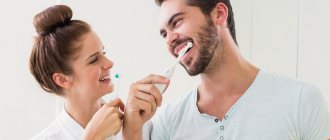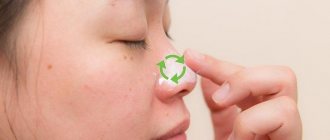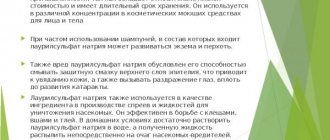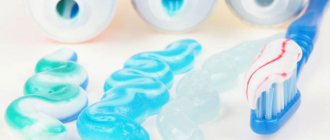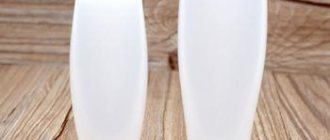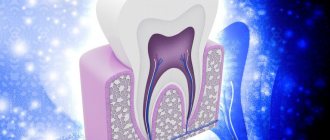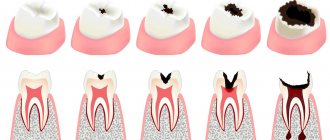Toothpaste is a mandatory attribute of personal hygiene and it is difficult to imagine a modern person who can do without oral care for a long time. Toothpaste not only eliminates bad breath, but is also a good preventive measure for quite serious diseases of the teeth and gums.
However, there may be situations when toothpaste may not be at hand, or its use for some reason is not advisable. In such situations, the question is quite natural: what can replace toothpaste ? The alternative option should be as safe as possible and at the same time quite effective. In order to decide what to replace toothpaste with , you need to pay attention to its composition.
Composition of toothpaste
- The basis. Almost any toothpaste is based on water and a mixture of glycerin and sorbitol, which acts as a binding component;
- Abrasives. Any paste contains abrasive particles in one quantity or another. In ordinary pastes there is a minimal amount of them, in pastes with a whitening effect they make up the largest part of the composition. Most often, silicon oxide derivatives are used as such abrasive particles;
- Foaming agents. The foam formed during the process of brushing teeth allows you to most effectively remove even microscopic particles removed from the surface, acting as a kind of dirt trap;
- Thickeners. These components are necessary to impart uniformity to the composition, making the paste convenient to apply to a toothbrush and distribute over the surface of the teeth;
- Excipients. Such substances include dyes, flavors, sweeteners and therapeutic and preventive additives that give an attractive color, in cases where we are talking about pastes with a targeted effect.
Having considered the composition and principle of action of toothpaste, you can reasonably select product options and make a decision: what can replace toothpaste with .
How to brush your teeth with an electronic brush?
As with a manual toothbrush, you should hold it at a 45° angle. But the steps are much simpler: you just need to move from tooth to tooth
. First - along the front surfaces, then - along the back and chewing surfaces, and finally - brush along the gum line and clean your tongue. You need to move the brush slowly: each tooth should have a few seconds of brushing. In total, the procedure takes the same amount of time as a manual one: two minutes. Your electric toothbrush may even have a timer set for this time.
Industrial toothpaste substitutes
Tooth powders
The most popular products include well-known tooth powders.
Teeth cleaning powders include:
- Calcium carbonate, which is the basis of the mixture;
- Supplements The role of additives is most often performed by clay, sodium carbonate and aluminum chloride;
- Flavors and flavoring additives;
- Excipients. Natural additives that perform certain functions are used as such substances. For example, essential oils have an antiseptic effect, sea salt has an antibacterial and anti-inflammatory effect.
The difference between powder when replacing toothpaste
- The abrasive particles of tooth powder are larger and sharper than those of toothpaste.
- The dry structure of the powder contains a large number of microparticles, allowing for better cleaning than a paste-like consistency.
- The powder contains fewer unnatural components than the paste.
- Toothpastes, due to their structure and the ability to add medicinal components, can be part of complex therapy for various diseases.
- Toothpastes, due to hermetic packaging and dosing capabilities, are considered more hygienic than powders sold in jars that open completely, causing the contents to come into contact with the external environment.
- Dry powders are not able to provide significant antimicrobial protection, unlike toothpastes.
- Tooth powder, being an abrasive product, may not be suitable for people with sensitive enamel.
- Toothpastes may contain quite aggressive chemical components sodium lauryl sulfate and triclosan.
- The powders are biologically neutral due to their natural composition.
Cons of tooth powders
The relative disadvantages of powders include the fact that with prolonged or frequent use, they, like whitening toothpastes, can lead to thinning of the enamel. In addition, if the powder is stored in an open container in close contact with the environment, it may become contaminated with pathogenic bacteria, which in turn can lead to infection of the mucous membranes of the oral cavity. Otherwise, tooth powder can be a worthy replacement for toothpaste in most cases.
Irrigators
Mechanisms that are acceptable for home use and essentially have no serious contraindications. The essence of the device is the targeted effect of a stream of water, which, due to the high pressure, washes away plaque and has a massaging effect on the gums.
It is customary to distinguish three main types of irrigators:
- Stationary. They operate from the network at a power of 220 Volts. The main operating mechanism is a compressor that provides water supply;
- Portable (travel). Work is carried out from a battery or batteries;
- Connected to the water supply network. Connect directly to the water tap using the included adapters.
The irrigator can have an effect on the oral cavity with both ordinary water and various medicinal compositions. In fact, this is one of the best options for replacing toothpaste for people of any age. The irrigator may be especially relevant for pregnant women, people who have orthopedic or prosthetic structures in their mouths, and people suffering from various diseases of the gums and mucous membranes.
Clay
What to do if you don't have toothpaste? How to brush your teeth? A good idea would be to use white or blue clay powder. The product is absolutely harmless to the body. The substance contains an abundance of microelements that disinfect oral tissues. Brushing your teeth with clay helps eliminate bad odor.
To rid the enamel of plaque, freshen breath and achieve a whitening effect, I act according to the following principle:
- take about 50-70 grams of white or blue clay;
- the product is moistened with a few drops of water;
- the product is mixed until a mass of paste-like consistency is formed;
- add a dessert spoon of liquid honey, as well as a couple of drops of propolis infusion, essential oils of sage and chamomile.
The prepared paste is applied to a damp brush. Brush your teeth, carefully treating the enamel surfaces. Finally, rinse your mouth with water. Performing the procedure in the morning and evening has the most positive effect on oral health.
How to replace toothpaste at home
Traditional (homemade) toothpaste substitutes include many substances and compositions. It is worth considering that it is not advisable to consider them as a long-term alternative, since their action is rather narrowly focused and in some cases their effectiveness does not have high indicators.
Activated carbon
Can be used both in pure form and with the addition of hydrogen peroxide. The latter has an antimicrobial effect, while the charcoal itself cleans and whitens tooth enamel. For one use, 1 tablet and 1-2 drops of peroxide are enough. Activated carbon does not require grinding, because upon contact with liquid it takes on a mushy state.
Charcoal has a good whitening effect. It should be noted that charcoal is a fairly active abrasive and, with prolonged use, can have a traumatic effect on tooth enamel.
Powder for teeth
You can prepare tooth powder at home by mixing: bentonite clay (30g), soda (30g), xylitol (15g), sea salt (7.5g), mint oil (5 drops), dried sage leaves (15g). The mixture is mixed with a wooden spatula and stored in a tightly closed container. This powder is a good replacement for toothpaste at home and in other conditions and is an almost exact analogue of the powder produced under industrial conditions. However, it is worth considering that any powder is an abrasive agent and requires short-term use to avoid damage to the enamel.
Salt
You can use either regular table salt or sea salt. Salt has a good anti-inflammatory effect, but it must be used carefully, mixed with water until it becomes pasty. Otherwise, hard particles with sharp edges can lead to microdamage to the enamel and cause increased tooth sensitivity.
Soda
It is another abrasive agent in the question of “ what to replace toothpaste with .” To create a cleaning mass, 1/2 teaspoon of baking soda must be mixed with 1/4 part of water. This mixture freshens breath and fights well against plaque on teeth, preventing the formation of tartar. To achieve a whitening effect, you can add 1-2 drops of lemon juice to the soda. Please note that after cleaning with soda, it is advisable to avoid drinking hot and cold drinks and food for 1-2 hours to prevent cracking of the enamel.
Herbal preparations
Mint, cloves, sage, thyme, anise and calamus root can be used as constituent units. Crushed roots of calamus can be mixed with an aqueous solution of propolis in almost arbitrary proportions.
The use of such mixtures has a beneficial effect on the gums and mucous membranes of the oral cavity. This type of hygiene products should be used with caution, taking into account the possibility of individual intolerance and the risk of developing allergic reactions.
Tea tree oil
Tea tree-based compositions have a good antibacterial and aromatizing effect. The composition is prepared by adding tea tree oil to warm water at the rate of 3-4 drops per glass of water. Such treatment has a particularly beneficial effect on the gums of people prone to developing periodontal disease and caries.
Banana peel
Few people know that banana peel has a good cleansing agent and whitening effect.
Powdered milk
Has a beneficial effect on the gums of people prone to bleeding. Produces gentle cleaning while neutralizing unpleasant odors.
Ash
You cannot use ash from resinous wood or recycled plywood. As a replacement for toothpaste, willow, birch, linden and oak are best suited for these purposes. Ash has a good bleaching effect and can serve as a good alternative to activated carbon due to its fineness, which allows for gentle cleaning.
White clay
It can be used both as an independent product and as part of a homemade combined tooth powder.
Laundry soap
Soap is a good antibacterial and antimicrobial agent. The main disadvantage of this method of cleaning teeth is the unpleasant taste in the mouth.
Lagerstroemia (Indian lilac)
A plant component with powerful antibacterial and anti-inflammatory effects. Provides a good therapeutic effect in the treatment and prevention of gingivitis, caries and some other diseases of the oral cavity.
Oils
Coconut oil and tea tree oil are popular alternatives to toothpaste. Most are used as rinsing solutions and as a component of herbal mixtures.
Healing herbs
When looking for effective folk remedies for cleaning teeth, you should pay attention to plants such as mint, sage, calamus root, thyme, and cloves. These herbs are combined in equal proportions and ground to a powdery consistency. The resulting product is applied to a moistened brush. Perform delicate teeth cleaning. Using the method allows you to remove plaque, disinfect the oral cavity and improve the condition of the gums.
What can you replace toothpaste with: conclusion
Having considered all of the above methods for replacing toothpaste, we can come to the conclusion that it is advisable to combine most of them, and some (salt, soda, charcoal, etc.) are not suitable for long-term use due to their powerful abrasive properties. One of the most effective and safe alternatives can be considered an irrigator and herbal mixtures.
In the question “ what to replace toothpaste with ,” all the methods indicated can be suitable, subject to the rules of use and the absence of abuse. We also recommend that you read our article: how often should you change your toothbrush, as well as the article on how to brush your teeth correctly:.
How to brush your teeth with a regular brush?
Hold the brush at a 45° angle to the gum line
. Bacteria and plaque usually hide in the sulcus of the gums. To get rid of them more effectively, the brush head should be slightly tilted towards the furrow. This gives an angle of 45°.
Brush your teeth using short, circular, back-and-forth sweeping movements.
. Not moving up and down - this is a common mistake. Don't press too hard on your teeth; this won't make them cleaner, but it will increase the risk of your teeth becoming hypersensitive and your gums bleeding. Here is an example video with the correct technique.
First, pay attention to the outer surface of the teeth, then to the inner, then to the chewing surfaces. To thoroughly clean the inner surface of the front teeth (a place that is difficult to reach, so do it separately, after chewing surfaces), change the angle and movements: hold the brush vertically and make forward-down movements - in this case they will be correct. Finally, clean your tongue. Even if there is no special scraper, the brush will cope with this quite well.
Kitchen salt
The mineral substance is known for its disinfecting properties. Thanks to its crystalline structure, the product perfectly cleanses plaque from tooth enamel. The effect of salt on the gums reduces the likelihood of developing inflammatory and putrefactive processes. The oral cavity gets rid of unpleasant odor.
You can use sea salt to clean your teeth. The product is a source of a wide range of microelements: iodine, manganese, phosphorus, calcium, silicon, iron. The noted elements have an antiseptic effect on the tissues of the oral cavity.
How to brush your teeth without toothpaste? The salt is thoroughly ground in a mortar until it becomes dusty. Add a couple of drops of vegetable oil. A damp brush is dipped in the substance. Next, teeth are brushed according to the usual principle. Finally, the oral cavity is thoroughly rinsed with water.
Myth 7. A brush with stiff bristles is the most effective.
Tamara Terekhova recommends buying toothbrushes with soft or medium hardness. Hard ones can only be used by patients with increased formation of pigmented plaque, who also have excellent enamel stability, strong gums, and single fillings. For others, it will injure the oral mucosa and contribute to the abrasion of enamel.
If you have problems cleaning interdental spaces and hard-to-reach places, preference should be given to brushes with milled tips. They easily penetrate into all areas of the tooth and do not injure the gums.
